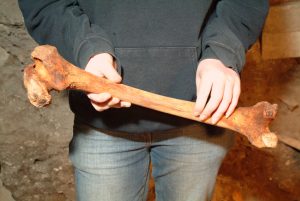It is surprising how many diseases, even relatively uncommon ones, can be identified in human remains uncovered during an archaeological dig. That was particularly true of the large dig which took place in the former East Kirk of St Nicholas in 2006. This blog deals with one of these less common conditions – usually known as Perthes Disease, but more properly known as Legg-Calve-Perthes disease (after the three doctors who identified the condition). The medical term is avascular necrosis.
The condition arises in childhood, between the ages of about 2 and 10, with the highest incidence in the range of 4-8 years. At this age, the bones are still growing, so anything which interferes with this is likely to cause problems. Perthes disease affects the head of the femur – the ball of the thigh bone which fits into the hip. For a reason which is not understood, there is an interruption of the blood supply to this actively growing region of the bone. That causes the bone cells to die – that is where the term avascular necrosis comes from. So the bone stops growing and there is a loss of bone mass resulting in a weakness and wearing away of the bone. At this stage a child will suffer aching in the hip (similar to ‘growing pains’) and may develop a limp. However, with time the blood supply re-establishes and the bone starts growing again. But damage will probably have been done to the bone during the phase when it was dead, often a change of shape will have occurred, so a deformity is a common outcome.

The photograph shows one of the examples found in the dig. This is of an adult man – it is more common in men – and the deformity of the ‘ball’ is quite clearly seen. The hip end of the femur is to the left, and the knee end to the right. At the head end of the bone, the ‘ball’ is pointing downwards. Obviously this is supposed to be round, but it clearly is not. The consequences for the sufferer is an initial shortening of the leg (it usually only affects one leg) giving a pronounced limp and there could be quite limited movement depending on the severity of the deformity. Longer term it is likely that osteoarthritis will develop with all the pain and difficulty which that will bring.
We are grateful to Paul Duffy, osteoarchaeologist, for the detailed studies on the human remains (http://www.discoverbutearchaeology.co.uk/).
(The photograph is copyright Aberdeen Art Gallery & Museums Collections and used with permission.)